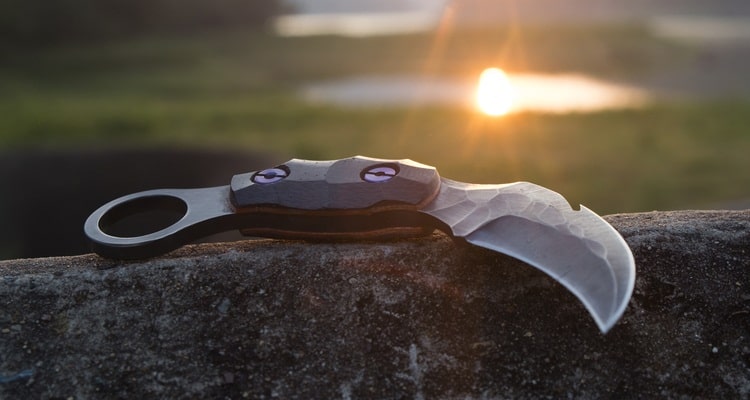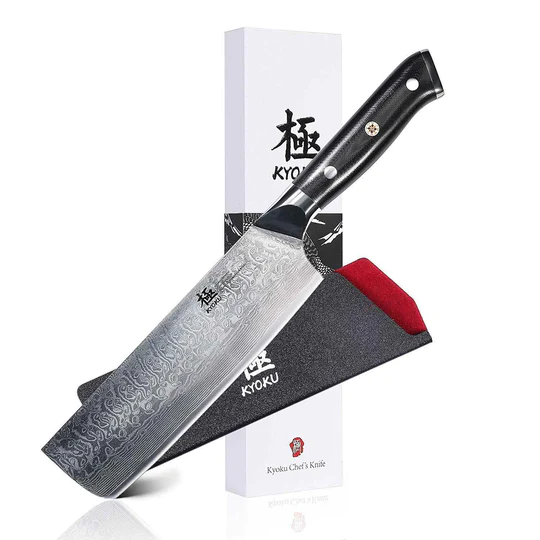


Karambit knives feature a unique curved blade and a finger ring. This design provides great control and precise movements. The best Karambit knives are sharp, durable, and easy to hold.
This knife guide will help you find the best Karambit for your needs.
The Karambit knife has its roots in Southeast Asia. It was first a farming tool for cutting roots and gathering crops. The knife was then adapted for close combat and self-defense.
The knife’s design is inspired by a tiger’s claw. Its curved blade lets you slice and hook easily. In Silat traditional martial arts, the Karambit is used for quick, precise strikes. Modern Karambit blades are now used for daily tasks. They are also effective for self-defense.
The Karambit is a great option for your everyday carry (EDC) if you need a small, sharp tool. Its curved blade is designed for control and precision. This knife is handy for cutting ropes, opening boxes, or cutting wood for a campfire.
When choosing an EDC Karambit, focus on size and ease of carry. Here are some features to consider:
| Feature | Why It Matters |
|---|---|
| Folding Mechanism | Keeps the blade safe and compact |
| Pocket Clip | Allows easy and secure carry |
| Blade Material | Affects sharpness and durability |
| Handle Grip | Improves control during use |
When choosing a Karambit knife, the blade material matters a lot. It affects how strong, sharp, and durable your knife will be.

Most Karambit blades are made from different types of steel. Stainless steel is common because it resists rust and is easy to keep clean. However, it can sometimes be softer and may need more sharpening.
High carbon steel is sharper and holds an edge longer. It can rust if you don’t care for it properly, so you need to keep the blade dry and oiled.
Some Karambits use tool steel or Damascus steel. Tool steel is tough and good for heavy use. Damascus steel has high carbon content. The blades have unique patterns and sharp edges.
The blade finish also impacts your knife. A coated blade can reduce glare and resist corrosion. A polished blade looks nice and can cut smoothly but might show scratches more easily.
The right blade material depends on how you plan to use your Karambit, and how much care you want to give it.
| Material | Rust Resistance | Edge Retention | Maintenance |
|---|---|---|---|
| Stainless Steel | High | Moderate | Low |
| High Carbon | Low | High | Moderate to High |
| Tool Steel | Moderate | High | Moderate |
| Damascus Steel | Moderate | High | Moderate |
The Karambit is often sharp on the inside edge, making it effective for close work. Karambit blade sizes range from 3 to 5 inches in blade length. Smaller blades are easier to carry and control. Larger ones give more reach but may be harder to handle in tight spaces.
Your handle grip is important when using a Karambit. Many handles have a finger ring at the base. This feature improves control and stops slipping. This ring allows you to twist the knife while keeping it secure in your hand.
Handle materials can include rubber, G-10, or wood. Rubber grips offer better traction when it’s wet. G-10 is a strong, light material used for its durability. Wood gives a traditional look but requires more care.
Choosing the right handle depends on your needs. Comfort and control should guide your decision.
| Material | Feel | Durability | Best For |
|---|---|---|---|
| Rubber | Soft, grippy | Medium | Everyday use |
| G-10 | Hard, textured | High | Heavy use, outdoor |
| Wood | Smooth, warm | Low to medium | Collectors, light use |
The Karambit knife features a curved blade that fits in your hand. This shape makes it easier to control the knife with quick movements.
The sharp curve enables quick slashing movements. You can use this knife to keep an attacker at a distance. Its design also makes it harder for someone else to take the knife from you.
When picking a Karambit for self defense, look for these features:
| Feature | Why It Matters |
|---|---|
| Finger Ring | Keeps the knife secure in hand |
| Sharp Blade | Ensures effective cuts |
| Compact Size | Easy to carry and conceal |
| Sturdy Handle | Provides a strong grip |
A double-edged Karambit has blades on both sides of the curved tip. This design can give you more cutting edges in a smaller blade size. It may be useful for precise cutting or utility work.
A double-edged Karambit can cut on both the inside and outside of the curve. This means you have more versatility in how you use the knife. But handling a double-edged Karambit requires extra care. The second edge raises the chance of accidental cuts if you’re not used to it.
Keep these features in mind when selecting a double-edged Karambit:
| Feature | Why It Matters |
|---|---|
| Blade material | A strong steel stays sharp longer |
| Handle grip | Prevents slipping during use |
| Safety sheath | Protects you when not in use |
Choosing the right Karambit means understanding blade materials, handle ergonomics, and legal restrictions. Proper maintenance and brand selection affect your knife’s performance and lifespan.
The Karambit is a tool made for close-quarters use. It’s not designed for long-distance defense or attacks. You should practice how to hold and draw the knife. This training will help you respond fast and prevent cutting yourself.
Folding Karambits offer better concealment and fit easily in your pocket. Most include pocket clips and compact designs for EDC. However, folding models need more maintenance because of their pivot points and locks. Fixed blades only need basic cleaning and sharpening.
Fixed blade knives are the fastest knives in existence for deployment. You can draw and use them immediately without opening mechanisms. Fixed blades give you more strength and reliability by removing mechanical failure points found in folding knives.
The LionSteel LE1 Karambits excel as an all-around choice with Ernest Emerson’s Wave Opener design. These knives feature CPM MagnaCut steel and integral aluminum construction.
The CRKT Provoke serves law enforcement and military personnel with its kinematic opening mechanism. You can deploy it from sheathed to ready in under one second.
The Bastinelli Knives PiKa Karambits weigh only 1.37 ounces while maintaining serious cutting power. The compact size makes these knives ideal for concealed carry situations.
The Cold Steel Steel Tiger offers fixed blade reliability with a rubberized handle that improves grip when wet.
LionSteel makes premium Karambits with integral handles milled from solid aluminum. Their knives use steel lock bar inserts for extra stability and reliability.
CRKT creates tactical designs with innovative opening mechanisms, focusing on rapid deployment for military and law enforcement.
Cold Steel manufactures robust fixed blade Karambits with rubberized handles and secure sheath systems. Their Steel Tiger model suits tactical applications.
Kershaw Knives offers assisted-opening models with Speed Safe technology. Their Outlier Karambit works for left-handed users and weak-side carry with reversible components.
In California, Karambits are legal for open carry as long as the blade is under 2.5 inches. Concealed carry laws differ between states and cities. Check your local regulations before carrying any Karambit for self-defense.
Using a knife for self-defense constitutes lethal force in most jurisdictions. The police can also take weapons involved in self-defense incidents as evidence.
Clean your Karambit after each use to prevent corrosion and buildup. Focus on the curved blade area where debris often collects.
Sharpen both sides of the Karambit blade unless it has a file-sharpened edge. The curved shape needs special sharpening tools or methods.
Lubricate folding mechanisms regularly to keep the knife working smoothly. Apply lubricant to pivot points and locking parts every month.
Store your Karambit in a dry place to avoid rust. Use blade oil on carbon steel models if you plan to store them for a long time.

Knife Buzz offers independent product reviews on a wide range of knives used in the kitchen, home, and outdoors. We make it easy for you to find the right knife at the best price.